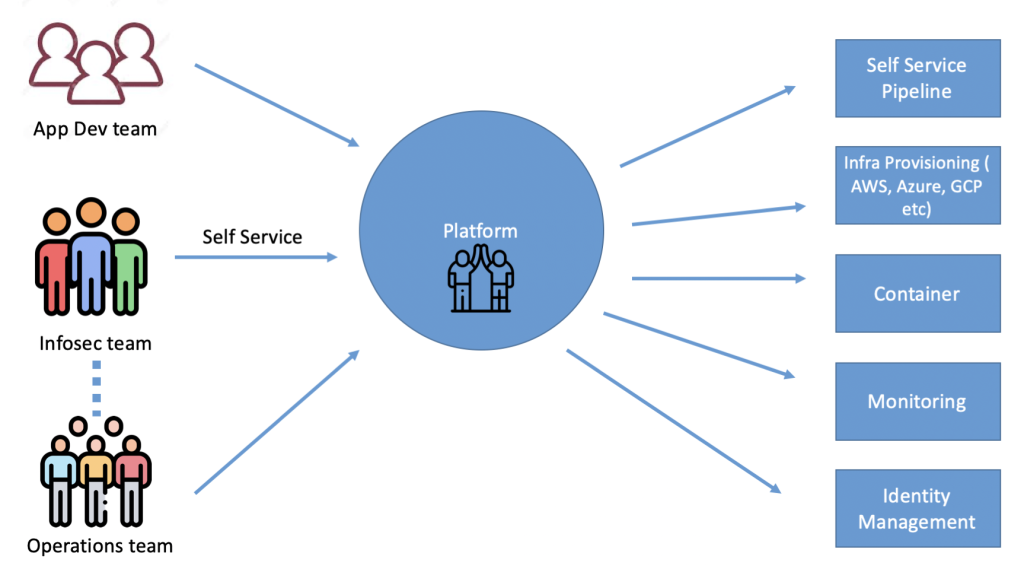What is platform engineering and what is the future?
Well…The future is platform engineering…
Gartner expects that by 2026, 80% of software engineering organizations will establish platform teams as internal providers of reusable services, components, and tools for application delivery.
As organizations look for various ways to improve application delivery while mitigating risk, platform engineering is emerging as a better and faster developer experience that can scale.
The platforms offer self-serve access to secure, validated, and reusable tools and workflows designed specifically for the development teams that will use them, increasing productivity while providing operational guardrails for security and stability. The reason for the rise in platform engineering is that developers are not able to manage the modern infrastructure as it is so complex. Any mistakes will lead to errors, security issues, or infrastructure configuration drift, which will delay the development time.

What is platform engineering?
Platform engineering improves developer experience and productivity by providing self-service capabilities with automated infrastructure operations. Platform engineering is trending because of its promise to optimize the developer experience and accelerate product teams’ delivery of customer value.
The value of Platform engineering:
Most of the operational complexity and friction will be reduced during the development process. There are many benefits that software organizations will see with the rise of platform engineering. It provides a stable alternative to the chaos and inefficiency of the build-it and run-it mindset. The confidence in building a large-scale application or enterprise application using a platform engineering team is much better compared to the traditional approach.
The main areas in which the platform engineering team will add value are:
- Building an internal development platform
- Maintaining internal SLA
- Standardizing key delivery processes
- Maintaining and monitoring team performance metrics
- Internal developer platform (IDP), which will work like a central collection of tools, services, and automated workflows that support rapid development and delivery. There will be a service layer, which will remove the complexities of configuring applications and setting up infrastructure. The main use case is that IDP will work like a self-service platform for any developer to build, test, deploy, and monitor applications all by themselves. Developers need not wait for the operations team to set up an infrastructure, manage tickets, etc.; they can easily spin up a cloud infrastructure, and trigger the integration and development pipeline for automated tests and deployments, access logs, build artifacts, and more from a single API or GUI.
- Maintaining an internal service level agreement (SLA): Platform engineers will ensure that they maintain an SLA. They will be accountable for any issues in the IDP. Platform teams treat IDPs as their products and developers as their customers. A failure of the internal system will reduce the productivity of the developer. The platform engineers will constantly monitor the health and performance of IDPs.
- Standardizing key delivery processes: Implementing IDP and having it managed by the platform engineers will standardize the delivery process. Developer productivity will be much better, and the deployment time will reduce drastically as the dependency on the operations team decreases.
- Maintaining and Monitoring Team Performance Metrics: Platform teams will continuously monitor the MTTR, workflow duration, incident management, removing bottlenecks, etc. If recovery times start to exceed the baseline, for example, platform teams may look to increase the number of automated tests in the pipeline or to improve the monitoring and alerting capabilities offered in the IDP. This will be a day-to-day activity for a platform engineer to streamline all the activities in SDLC by constantly monitoring the team’s performance metrics.
A well-defined workflow for the engineering team, with a clear understanding of the roles and responsibilities of each team member, is an important prerequisite. You are bound to have a platform team as you see the product scaling up. The platform team will ensure success, irrespective of the size of the engineering team.

Conclusion:
Forming a platform engineering team is one way an organization could begin modernizing its engineering culture. There are other ways as well, but organizations with critical cloud infrastructure and teams moving to a microservice-based architecture can bet on the platform team to streamline the entire development process. Building and maintaining awareness of the technology landscape can help an organization form a stronger opinion on the need for a platform team.







